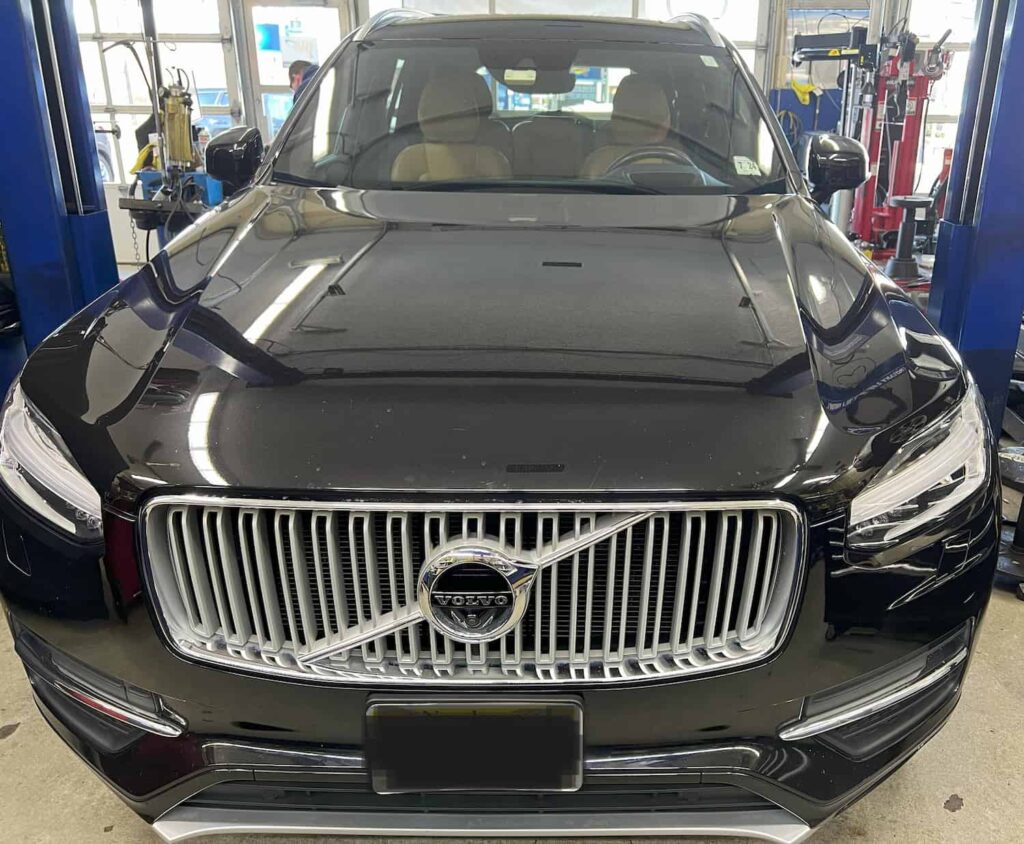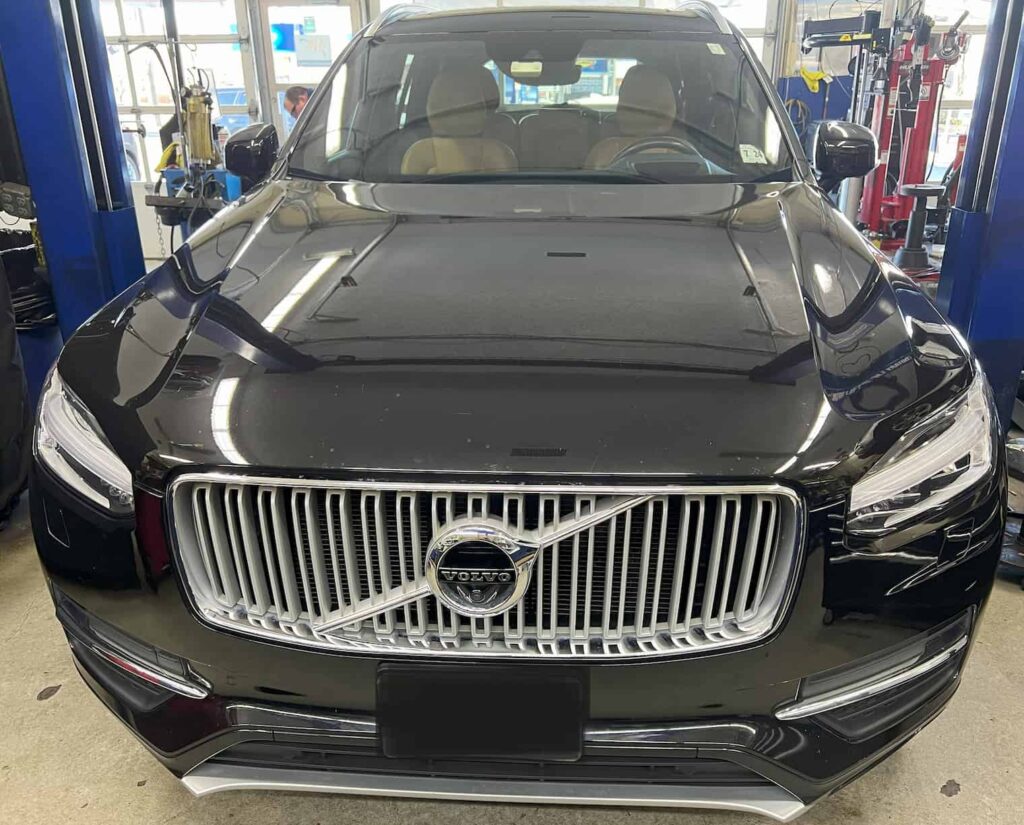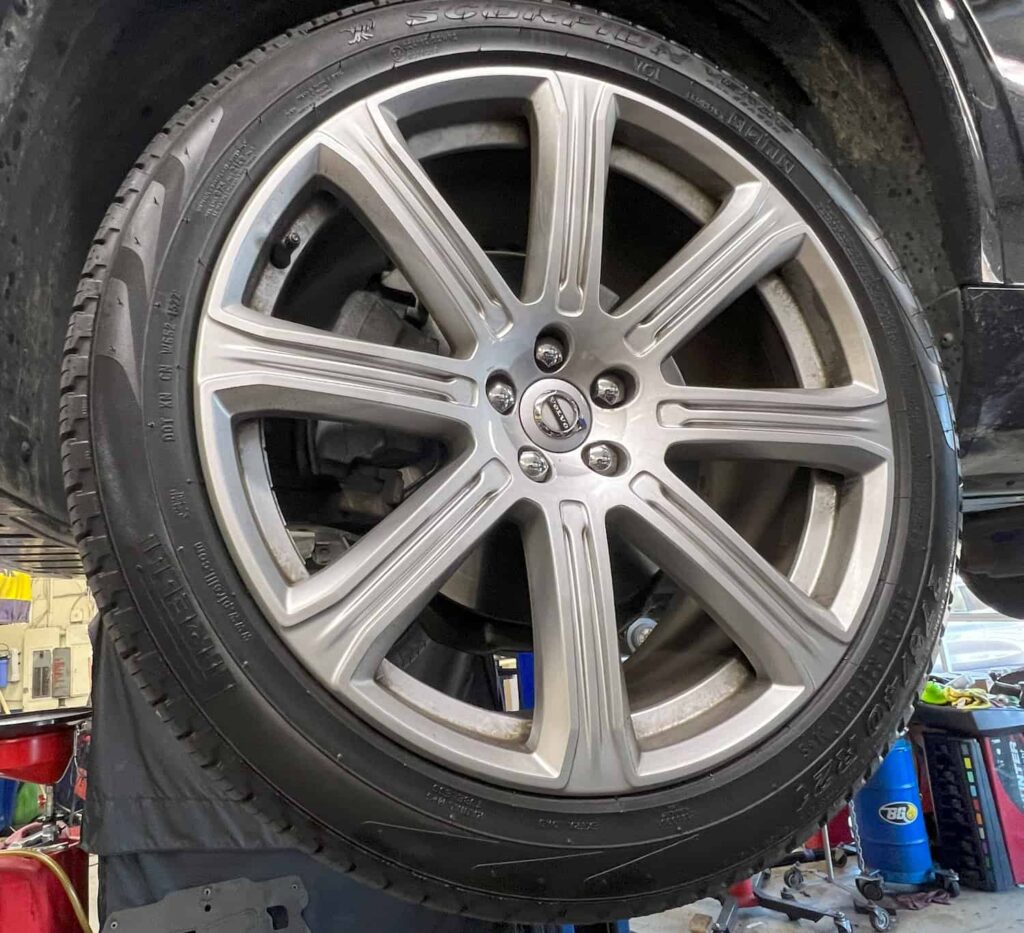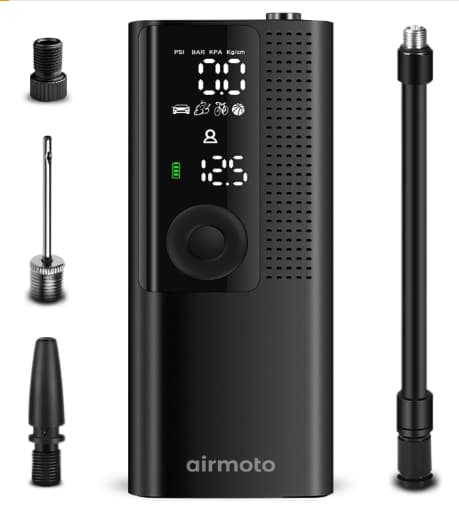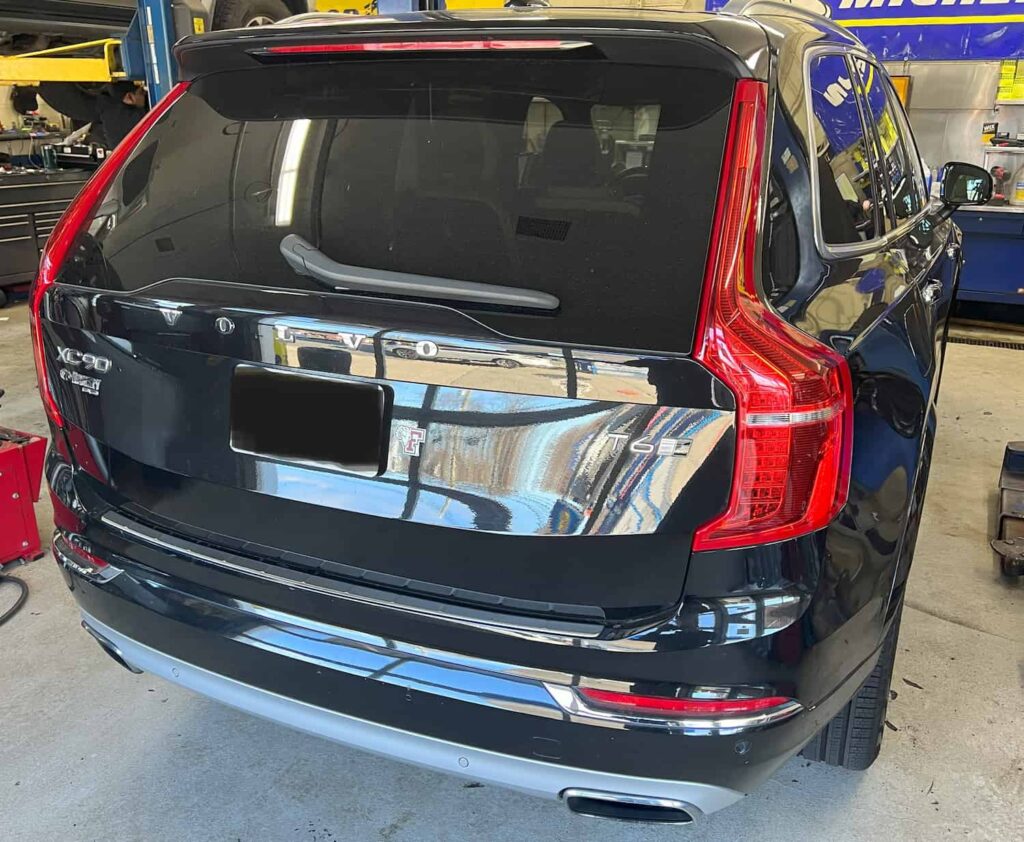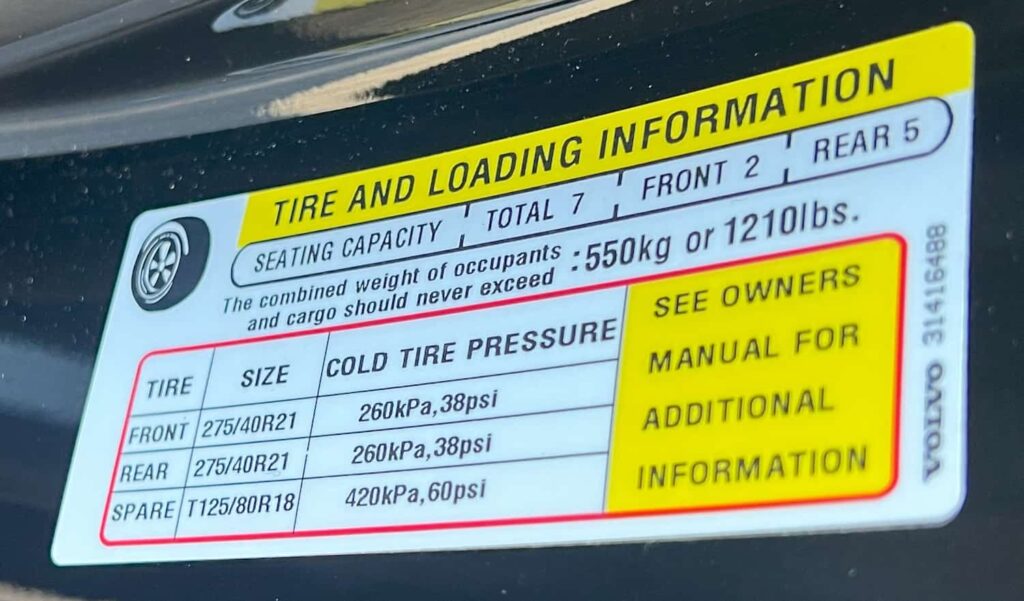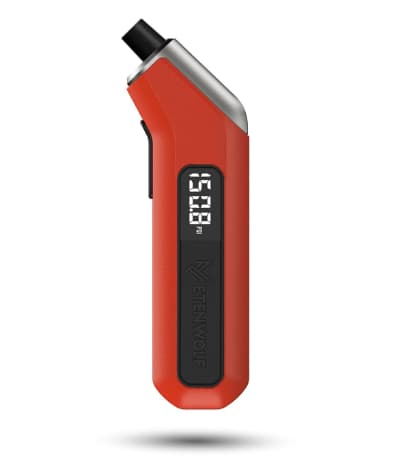Steps to Reset Volvo XC90 Tire Pressure Monitoring System
Before following the Volvo XC90 TPMS reset procedure, check and inflate all four tires to the recommended air pressure while the tires are cold (before driving).
STEP 1: START ENGINE
Start the Volvo XC90 engine or put the vehicle into RUN mode by turning the ignition switch twice without your foot on the brake pedal.
STEP 2: SETTINGS
Press the settings button directly underneath the information display screen.
STEP 3: SWIPE THE SCREEN
Swipe across the information display screen until all the menu options appear.
STEP 4: CAR STATUS
Select CAR STATUS from the menu options.
STEP 5: TPMS
Select TPMS on the left side of the information display screen.
STEP 6: STORE PRESSURE
Press the STORE PRESSURE option.
STEP 7: CONFIRMATION
A message will appear that reads “Store Tire Pressure” “Press OK after the tire pressure in all four tires has been checked and adjusted”. Select OK.
Another message will appear that reads “Tire Pressure Monitor” “Storing pressure is in progress and will finalize automatically.” Select OK.
WHAT IS TPMS?
The Volvo TPMS is an abbreviation for tire pressure monitoring system. The Volvo XC90 uses an indirect tire pressure system which means it uses data from its wheel speed sensor to measure tire pressure instead of tire pressure sensors in each individual wheel.
HOW DOES VOLVO INDIRECT TPMS WORK?
The Volvo XC90 Tire Pressure Monitoring System (TPMS) works without direct tire pressure sensors. Instead it functions by using the vehicle’s Anti-lock Braking System (ABS) sensors, specifically the wheel speed sensors. These types of systems are known as indirect TPMS. Here’s how they work:
WHEEL SPEED SENSORS
Indirect TPMS uses the ABS’s wheel speed sensors. Each wheel has a sensor that monitors its rotational speed. Wheel speed sensors are located directly behind each wheel.
COMPARISON OF WHEEL ROTATIONS
The principle behind indirect TPMS is that a tire with lower air pressure than the others will have a slightly smaller diameter, causing it to rotate faster than the other 3 tires. The TPMS compares the rotational speed of all four wheels. Indirect TPMS only functions when the Volvo XC90 is being driven because it cannot calculate tire air pressure unless a wheel speed is being recorded.
CALCULATING PRESSURE DIFFERENCES
By analyzing the data from the wheel speed sensors, the Volvo tire pressure system can detect when one wheel is rotating consistently faster than the others, indicating a possible reduction in tire air pressure.
ALERTING THE DRIVER
Once the system identifies a significant difference in rotational speed, suggesting a pressure loss, it triggers a warning light on the dashboard to alert the driver. If triggered, the Volvo XC90 will have a “low tire pressure” warning as well as the standard low tire pressure alert symbol on the dashboard.
WHAT CAN CAUSE THE TREAD CIRCUMFERENCE OF A TIRE TO CHANGE?
If a tire’s inflation pressure is too low.
If all 4 tires aren’t the same brand make and model.
If all 4 tires aren’t the exact same size.
If the tire’s tread is damaged or the tire is structurally damaged.
If one side of the Volvo XC90 is more heavily loaded than the other.
If there is more weight on one axle than the other (such as when towing a trailer).
If a compact spare wheel has been mounted.
If a wheel was replaced on each axle.
If a tire was changed.
If the tire pressure was changed, or wheels were rotated or replaced.
If there are snow chains on the tires. Using snow chains can cause the system to give false warnings because snow chains increase tire circumference.
WHEN SHOULD YOU RESET & STORE THE VOLVO XC90 TPMS?
After inflating the air pressure in any tire.
After servicing or repairing a tire or wheel.
After rotating the tires.
After any tire or wheel is removed from the Volvo XC90 and put back on.
After mounting the spare tire.
WHAT DOES STORING AND RESETTING THE VOLVO XC90 TIRE AIR PRESSURE ACTUALLY DO?
When you store new tire pressures you are setting and changing a new benchmark for the tire air pressure. This is why it is essential to set the air pressure to the correct recommended pressure levels while the tires are cold before storing new air pressure levels.
WHAT HAPPENS WHEN TIRES ARE UNDER INFLATED?
Low tire pressure can cause the tires to overheat which can result in tread separation and blowouts. Tires with excessively low pressure cause the sidewall of the tire to flex (bend) more, which can cause the tire to overheat and fail without warning.
WHY IS THE TIRE PRESSURE LIGHT ON WHEN THE TIRES ARE FINE?
A very common reason the tire light is on when the tires are fine is due to different brand and size tires on the Volvo XC90. Due to how indirect TPMS works, the smallest difference in tire size or brand will cause the low tire pressure alert to turn on. All 4 tires need to match in tire size, brand, make and model.
HOW DO I KNOW WHICH TIRE IS LOW ON MY VOLVO XC90?
The Volvo XC90 information display screen will show you which wheel location on the vehicle is low on air pressure. In order for the Volvo XC90 TPMS to work properly, you must drive. Use a digital air pressure gauge to check and confirm each tire’s air pressure matches with what the information display is showing.
IS IT SAFE TO DRIVE THE VOLVO XC90 WITH THE TIRE PRESSURE LIGHT ON?
No it is not recommended to drive the Volvo XC90 when the low tire pressure alert is active. If the low tire pressure light turns on, pull over and manually check each tire’s air pressure level with a digital tire pressure gauge.
HOW FAR CAN YOU DRIVE WITH THE TIRE LIGHT ON?
There is not a “safe” distance or time you can drive with the low tire pressure light on. We recommend determining why the low tire light is on before continuing to drive.
VOLVO XC90 TIRE SIZE AND AIR PRESSURE
TIRE SIZE | Front Psi/kPa | Rear Psi/kPa |
275/40R21 | 38/262 | 38/262 |
275/35R22 | 38/262 | 38/262 |
SPARE | 60 | 60 |
WILL THE VOLVO TIRE PRESSURE LIGHT COME ON IF OVERINFLATED?
The Volvo XC90 will display an overinflated tire on the information display screen. Pull over and manually check the air pressures of each tire. Remember that driving heats up the tires naturally which causes air pressure to increase. Wait for the tires to cool (3 hours after driving) to get an accurate reading on tire air pressure level.
HOW TO FIND OUT WHERE A TIRE IS LEAKING FROM USING SOAP AND WATER?
If you have a tire that’s losing air, follow these steps to find the location of the tire leak:
Inflate the deflating tire of your Volvo XC90 to a pressure of 40 Psi.
Mix a solution by combining water and liquid soap in a spray bottle.
Liberally spray the soapy mixture across the tire’s surface, don’t forget to spray the bead and valve stem areas.
Observe the formation of bubbles and trace their origin to find the source of the leak.
CAN A CHANGE IN ALTITUDE TRIGGER THE TIRE PRESSURE FAULT?
Your Volvo XC90’s TPMS light probably won’t turn on just because you’re driving to a higher altitude. When you go up in elevation, the air pressure inside your tires actually goes up. The tire pressure increases by an estimated 0.5 Psi for every 1,000 feet you climb.
CAN THE VOLVO XC90 TPMS BE DISABLED?
The Volvo XC90 TPMS cannot be disabled.
USING WINTER TIRES OR A CHANGE OF WHEELS
If you use a set of winter tires or have a second set of wheels and tires you must store the new tires on the information display. Any mismatching tires or wheel sizes will cause the Volvo XC90 low tire alert to turn on.
CAN THE WEATHER TRIGGER THE VOLVO XC90 TPMS LIGHT?
A frequent reason for the activation of the low tire pressure warning in the Volvo XC90 is atmospheric temperature fluctuations. Tire pressure typically alters by approximately 1 Psi (6.8 kPa) for every 10°F shift in temperature. For instance, a decrease in temperature by 45°F over the course of 2 months can lead to a reduction in tire pressure from 37 Psi to 32 Psi in the Volvo XC90, triggering the tire warning indicator. Since temperature changes are a common occurrence, especially in certain regions, it’s advisable to routinely check the tire pressure of your Volvo XC90 every few weeks. It’s important to do this check when the tires are cold (before driving less than a mile) for accurate readings and to prevent any tire-related complications.
DOES TIRE AIR PRESSURE IMPACT VOLVO XC90 FUEL CONSUMPTION?
Keeping the right tire pressure in the Volvo XC90 is essential for maximizing fuel efficiency. When tires are underinflated, they create more rolling resistance, forcing the engine to exert more effort and, consequently, consume more fuel. A decrease in tire pressure by 1 Psi across all 4 tires can lead to a reduction in fuel efficiency by about 0.2%. This means that an underinflation of 5 Psi, which is quite common, might result in a 1% drop in the Volvo XC90’s miles per gallon (MPG). To put it into perspective, for a vehicle like the Volvo XC90, which typically gets 23-24 MPG, a 1% reduction in fuel efficiency equates to additional fuel consumption – roughly an extra gallon for every 2,500 miles traveled.
ARE TIRE PLUGS SAFE?
With a decade of experience as an automotive technician, I frequently use tire plugs for fixing tire punctures and find them to be safe and efficient when applied properly. However, it’s important to avoid using tire plugs on tires with significantly worn treads or on the sidewall of the tire. In cases where the puncture or leak is sizable, opting for a tire patch or outright tire replacement is the better course of action.
Everything in this article is applicable to all Volvo XC90 models and versions built between 2015-2024 including the Volvo XC90 Recharge (plug in hybrid),
2019 VOLVO XC90 MANUAL: https://volvornt.harte-hanks.com/manuals/2019/XC90_OwnersManual_MY19_en-US_TP25803.pdf
Please note that this blog post contains Amazon affiliate links. This means that if you make a purchase through one of these links, we at TPMSRESET.COM may earn a small commission at no extra cost to you. We only recommend products that we personally use and believe in. Thank you for supporting us.
